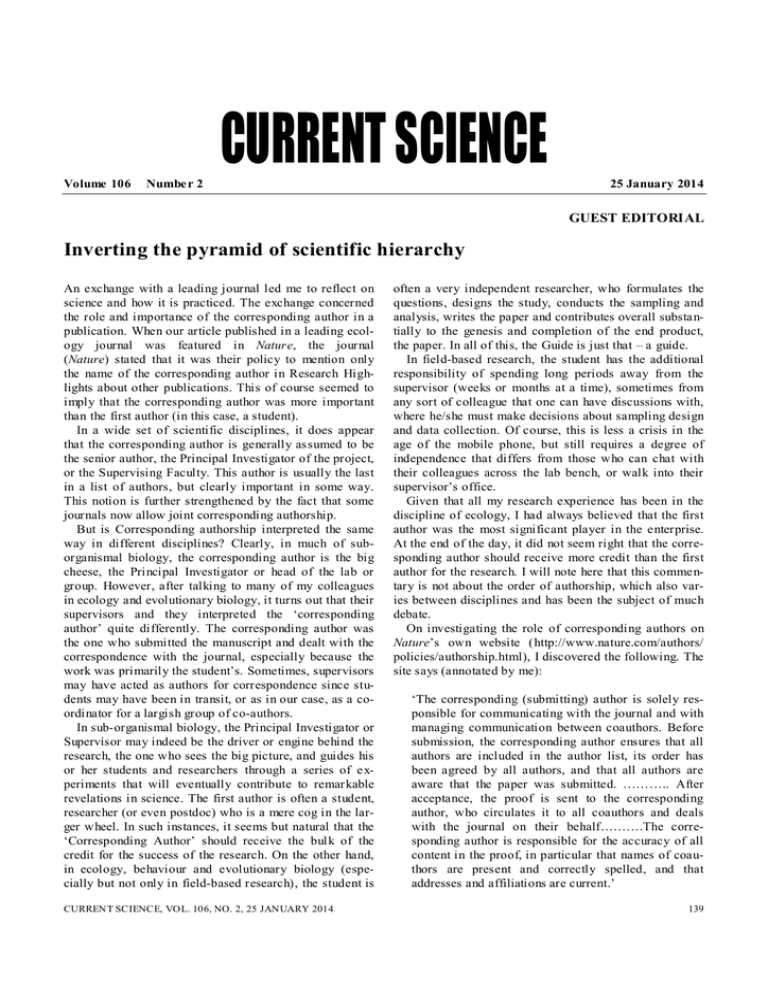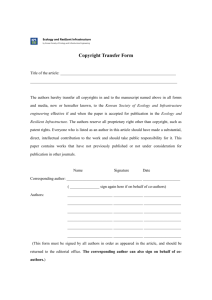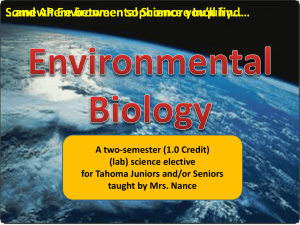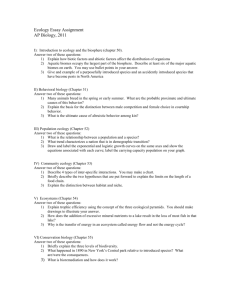CURRENT SCIENCE Inverting the pyramid of scientific hierarchy GUEST EDITORIAL
advertisement

CURRENT SCIENCE Volume 106 Numbe r 2 25 January 2014 GUEST EDITORIAL Inverting the pyramid of scientific hierarchy An exchange with a leading journal led me to reflect on science and how it is practiced. The exchange concerned the role and importance of the corresponding author in a publication. When our article published in a leading ecology journal was featured in Nature, the journal (Nature) stated that it was their policy to mention only the name of the corresponding author in Research Highlights about other publications. This of course seemed to imply that the corresponding author was more important than the first author (in this case, a student). In a wide set of scientific disciplines, it does appear that the corresponding author is generally assumed to be the senior author, the Principal Investigator of the project, or the Supervising Faculty. This author is usually the last in a list of authors, but clearly important in some way. This notion is further strengthened by the fact that some journals now allow joint corresponding authorship. But is Corresponding authorship interpreted the same way in different disciplines? Clearly, in much of suborganismal biology, the corresponding author is the big cheese, the Principal Investigator or head of the lab or group. However, after talking to many of my colleagues in ecology and evolutionary biology, it turns out that their supervisors and they interpreted the ‘corresponding author’ quite differently. The corresponding author was the one who submitted the manuscript and dealt with the correspondence with the journal, especially because the work was primarily the student’s. Sometimes, supervisors may have acted as authors for correspondence since students may have been in transit, or as in our case, as a coordinator for a largish group of co-authors. In sub-organismal biology, the Principal Investigator or Supervisor may indeed be the driver or engine behind the research, the one who sees the big picture, and guides his or her students and researchers through a series of experiments that will eventually contribute to remarkable revelations in science. The first author is often a student, researcher (or even postdoc) who is a mere cog in the larger wheel. In such instances, it seems but natural that the ‘Corresponding Author’ should receive the bulk of the credit for the success of the research. On the other hand, in ecology, behaviour and evolutionary biology (especially but not only in field-based research), the student is CURRENT SCIENCE, VOL. 106, NO. 2, 25 JANUARY 2014 often a very independent researcher, who formulates the questions, designs the study, conducts the sampling and analysis, writes the paper and contributes overall substantially to the genesis and completion of the end product, the paper. In all of this, the Guide is just that – a guide. In field-based research, the student has the additional responsibility of spending long periods away from the supervisor (weeks or months at a time), sometimes from any sort of colleague that one can have discussions with, where he/she must make decisions about sampling design and data collection. Of course, this is less a crisis in the age of the mobile phone, but still requires a degree of independence that differs from those who can chat with their colleagues across the lab bench, or walk into their supervisor’s office. Given that all my research experience has been in the discipline of ecology, I had always believed that the first author was the most significant player in the enterprise. At the end of the day, it did not seem right that the corresponding author should receive more credit than the first author for the research. I will note here that this commentary is not about the order of authorship, which also varies between disciplines and has been the subject of much debate. On investigating the role of corresponding authors on Nature’s own website (http://www.nature.com/authors/ policies/authorship.html), I discovered the following. The site says (annotated by me): ‘The corresponding (submitting) author is solely responsible for communicating with the journal and with managing communication between coauthors. Before submission, the corresponding author ensures that all authors are included in the author list, its order has been agreed by all authors, and that all authors are aware that the paper was submitted. ……….. After acceptance, the proof is sent to the corresponding author, who circulates it to all coauthors and deals with the journal on their behalf……….The corresponding author is responsible for the accuracy of all content in the proof, in particular that names of coauthors are present and correctly spelled, and that addresses and affiliations are current.’ 139 GUEST EDITORIAL Post publication, the corresponding author’s responsibilities are: ‘The journal regards the corresponding author as the point of contact for queries about the published paper……..This author does not have to be the senior author of the paper or the author who actually supplies materials; this author's role is to ensure enquiries are answered promptly on behalf of all the co-authors.’ The last line is telling. By Nature’s own admission, the corresponding author is not (necessarily) the most important intellectual contributor to a piece of scientific research. And yet that appears to be the underlying paradigm in science, or at least in much of biology, today. There is another factor. Corresponding authorship is often treated as a badge of honour, either in peer recognition or even in formal processes such as job promotion, or election to scientific societies and academies. Hence, collaborators vie for it, and students are denied an opportunity because their supervisors feel that they require it. Or would be looked down on if they were not corresponding authors on their papers. Science clearly works differently in its various forms and disciplines. But why should ecology be different from other biological sciences? Perhaps it has something to do with the fact that ecology and evolutionary biology go beyond most sub-organismal biological sciences in examining ultimate causation. We ask the critical ‘Why’ question. And maybe this plays a role in the contribution that the field makes to the philosophy and practice of science. It is a student-driven science and promotes the value of independent thinking. For the last four years, students of ecology, evolution and conservation science have organized their own conference in several different parts of the country, from Bangalore to Guwahati to Dehradun, and now Nagaland. Every aspect of the conference is planned and executed by a student body, and decisions are taken through debate and discussion (and online voting). The students plan and conduct over 20 workshop on a range of topics in ecology and evolution, and provide training and skills in quantitative ecology, genetics, GIS, and so on. Various speakers and experts are invited to conduct workshops and give plenary talks. Over 300 students attend the meeting each year. Several thousand now populate their mailing lists. 140 How did such a movement come about? In 2009, students of a few academic institutions and non-government research organizations in Bangalore and Mysore came together informally to share their experiences. When more than a 100 participants attended, it became apparent that the community needed such a forum. Soon enough, other students of ecology around the country asked why this was restricted to this small group, and organically, the meeting became national, and was named YETI (Young Ecologists Talk and Interact). After a couple of years in Bangalore, students from other regions expressed an i nterest in conducting the event. On two occasions, the event has been held in the Northeast, a region where students have had little opportunity to interact with peers and engage with other ecologists. From the beginning, the YETI community has been concerned about this disparity in access to facilities, funding and support, and strived to provide opportunities to their peers from less privileged areas and institutions, including by moving the conference around. This maturity and vision matches and sometimes surpasses what their more grizzled colleagues have shown. Of course, there has also been widespread support from established ecologists, both post-doctoral fellows and young faculty around the country. Few people would disagree that the growth of science itself is likely to be served by supporting and promoting independent young researchers. But, in practice, the scientific establishment is hierarchical, and not just in India of course. The Nature incident only serves as a small illustration of the attitudes within our community, but it would be well worth taking heed of these signals. We often wonder why, despite the size of its community, India lags behind other countries in producing quality science. At least in part, the deeply entrenched hierarchies in our system must be to blame. From government committees to science societies to academic institutions, our systems are inherently top-down. Perhaps it is time to turn the tables and invert our notion of importance, placing students in the top part of that pyramid. As much as we would like to be centres of scientific revolutions, we should equally aspire to be the substrates for such revolutions. Kartik Shanker Centre for Ecological Sciences, Indian Institute of Science, Bangalore 560 012, India e-mail: kshanker@ces.iisc.ernet.in CURRENT SCIENCE, VOL. 106, NO. 2, 25 JANUARY 2014





